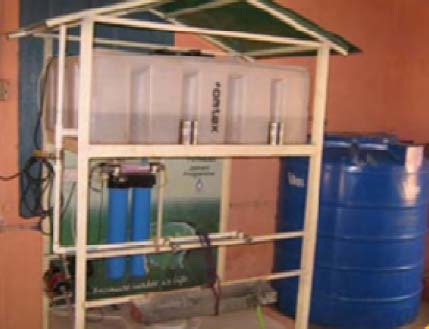 This report by the Centre for Media Studies, New Delhi presents an assessment of the Jalamani programme of the Department of Drinking Water Supply, Government of India. The centrally sponsored programme commenced in 2008-09 aimed at installing simple Stand Alone Water Purification Systems (SAWPS) in rural schools to enable school children to have access to safe and clean water. The focus was on tackling bacteriological contamination and turbidity in ongoing rural drinking water supply programme.
This report by the Centre for Media Studies, New Delhi presents an assessment of the Jalamani programme of the Department of Drinking Water Supply, Government of India. The centrally sponsored programme commenced in 2008-09 aimed at installing simple Stand Alone Water Purification Systems (SAWPS) in rural schools to enable school children to have access to safe and clean water. The focus was on tackling bacteriological contamination and turbidity in ongoing rural drinking water supply programme.
The assessment study used both qualitative and quantitative techniques such as focus group discussions and in-depth interviews besides structured questionnaire for a variety of stakeholders and research questions. Another important aspect of the quantitative tools was testing of the raw and treated water samples. The study was undertaken in 320 schools spread across 20 districts and six states.
Key findings of the study include -
- Huge gap of 59 per cent between installation and usage of SAWPS;
- Limited knowledge and awareness on significance of SAWPS among key stakeholders;
- The criteria for selection of schools varied from state to state and contamination was not always the leading reason for SAWPS installation;
- SAWPS technology inefficiency is a major concern;
- Lack of communication between different stakeholders was observed more or less in all the sample states especially at schools and panchayats level;
- Suppliers’ performance is a major concern in all the sample states and at present no system exists to monitor their performance;
The recommendations and future outlook include -
- Reframe Jalamani guidelines to incorporate process of school selection, school orientation, handing over of SAWPS, post installation monitoring and pre and post installation water testing;
- Improved awareness and education;
- Implementing agency shall play the role of sheet anchor for successful implementation of the Jalamani Programme. It should have a clear structure and system in place with obvious division of roles and responsibilities;
- Convergence of Jalamani scheme with other schemes like SSA, ICDS, SHHE etc.
- Selection of supplier preferably at district level and besides the price offer, technical expertise and competence of the company should be considered. The implementing agency shall periodically update its database of suppliers;
- Implementing agency shall make it mandatory for the suppliers to certify the product’s water quality from the accredited laboratory after installation of SAWPS in schools;
- O&M contract with suppliers;
- Apart from iron, turbidity, faecal coliform and total coliform other contaminants (fluorides, arsenic etc), which have direct health impacts on the children should be considered while selecting the technology;
- SAWPS design may consider aspects such as water feeding (direct connection of SAWPS from water source to the tank), easy accessibility (4-5 taps connection outside), height of the filter taps in accordance with the average height of the students and drainage system for waste water;
- Third party evaluation of supplier performances;
- Handing over process shall only be followed between schools and implementing agency;
- The School Management Committee (SMC) should be held accountable for the smooth functioning (daily upkeep and maintenance) of the SAWPS;
- Behavioral change communication;
- The implementing agency may either get the water quality testing done in its laboratories or through NABL accredited labs;
- The participation of panchayat/panchayat level committee needs to be encouraged;
- MIS system and web based monitoring systems need to be developed.
Download the report here -
/articles/assessment-jalamani-programme-stand-alone-water-purification-systems-rural-india-report